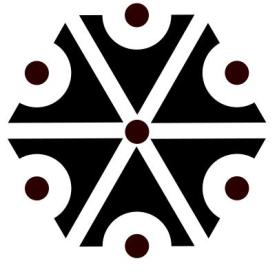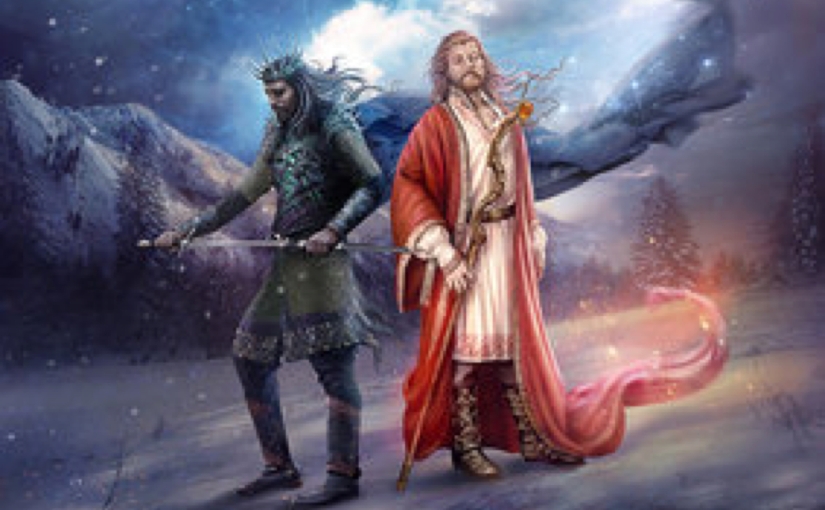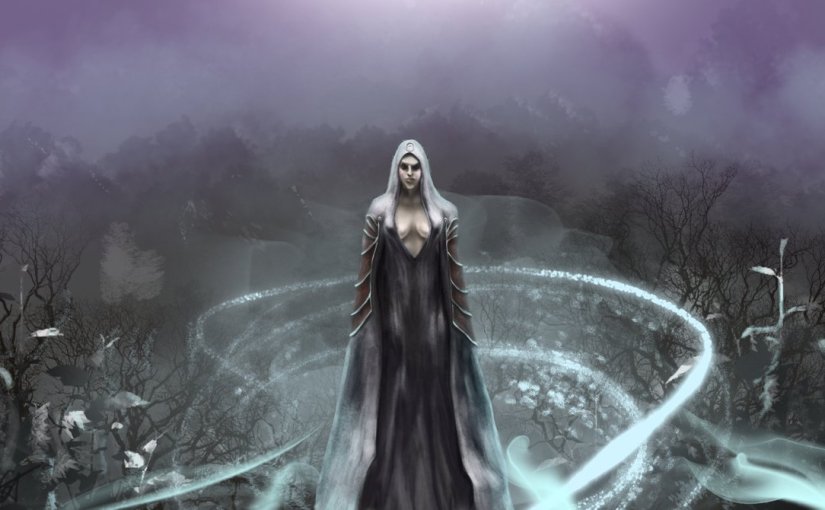 Rod or Rid (Polish, Slovenian, Croatian: Rod, Belarusian, Bulgarian, Russian, Serbian Cyrillic: Род, Ukrainian Cyrillic: Рід)[note 1] is a conception of supreme God of the universe and of all its gods in Slavic Native Faith(Rodnovery). The same concept is also known as Sud (“Judge”) and Prabog (“Pre-God”, “First God”) among South Slavs. The term rod is attested in Old Church Slavonic sources about pre-Christian religion, where it refers to divinity and ancestrality. Michel Mathieu-Colas (2017) defines it as the “primordial God”, but the term also literally means the generative power of family and “kin”, “birth”, “origin” and “fate” as well. The negative form of the term rod, that is urod, means something wrenched, deformed, degenerated, monstruous. Nadaljuj z branjem Rod
Rod or Rid (Polish, Slovenian, Croatian: Rod, Belarusian, Bulgarian, Russian, Serbian Cyrillic: Род, Ukrainian Cyrillic: Рід)[note 1] is a conception of supreme God of the universe and of all its gods in Slavic Native Faith(Rodnovery). The same concept is also known as Sud (“Judge”) and Prabog (“Pre-God”, “First God”) among South Slavs. The term rod is attested in Old Church Slavonic sources about pre-Christian religion, where it refers to divinity and ancestrality. Michel Mathieu-Colas (2017) defines it as the “primordial God”, but the term also literally means the generative power of family and “kin”, “birth”, “origin” and “fate” as well. The negative form of the term rod, that is urod, means something wrenched, deformed, degenerated, monstruous. Nadaljuj z branjem Rod
Kategorija: Tuji članki
Belobog
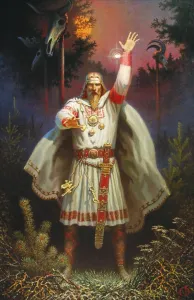 Belobog, Bilobog, Belbog, Bialbog, Byelobog, Bielobog, Belun or Bylun, Bielboh or Bialun (Belarusian: Белбог, Бялун) (all names meaning White God) is a reconstructed Slavic deity of light and Sun, the counterpart of dark and cursed Chernobog (Black God). It is uncertain whether such a deity was ever worshipped by polytheist Slavs, as there are no reliable historic records which mention this name. While in the past a great deal of scholars studying Slavic mythology took the dualism of Belobog and Czernobog for granted, modern research of the matter makes this theory very hard to maintain. Nadaljuj z branjem Belobog
Belobog, Bilobog, Belbog, Bialbog, Byelobog, Bielobog, Belun or Bylun, Bielboh or Bialun (Belarusian: Белбог, Бялун) (all names meaning White God) is a reconstructed Slavic deity of light and Sun, the counterpart of dark and cursed Chernobog (Black God). It is uncertain whether such a deity was ever worshipped by polytheist Slavs, as there are no reliable historic records which mention this name. While in the past a great deal of scholars studying Slavic mythology took the dualism of Belobog and Czernobog for granted, modern research of the matter makes this theory very hard to maintain. Nadaljuj z branjem Belobog
Chernobog
 Chernobog (from Proto-Slavic *čĭrnŭ ‘black’ and *bogŭ “god”) – also spelled as Chernabog, Czernobog, Chornoboh, Czorneboh, Čiernoboh, Crnobog, Tchernobog and Zcerneboch among other variants – is a Slavic deity, whose name means black god, about whom much has been speculated but little can be said definitively. The only historical sources, which are Christian ones, interpret him as a dark, accursed god, but it is questionable how important or malicious he was really considered to be by ancient Slavs. The name is attested only among West Slavic tribes of the 12th century, hence it is speculated that he was not a very important or very old deity. Older scholarship assumed him to be the counterpart of Belobog.
Chernobog (from Proto-Slavic *čĭrnŭ ‘black’ and *bogŭ “god”) – also spelled as Chernabog, Czernobog, Chornoboh, Czorneboh, Čiernoboh, Crnobog, Tchernobog and Zcerneboch among other variants – is a Slavic deity, whose name means black god, about whom much has been speculated but little can be said definitively. The only historical sources, which are Christian ones, interpret him as a dark, accursed god, but it is questionable how important or malicious he was really considered to be by ancient Slavs. The name is attested only among West Slavic tribes of the 12th century, hence it is speculated that he was not a very important or very old deity. Older scholarship assumed him to be the counterpart of Belobog.
Svetovid
 Svetovid, Svantovit or Sventovit is a Slavic deity of war, fertility and abundance primarily venerated on the island of Rügen into the 12th century. He is often considered a local Rugian variant of the pan-Slavic god Perun. Sometimes referred to as Beli (or Byali) Vid (Beli = white, bright, shining), Svetovid is associated with war and divination and depicted as a four-headed god with two heads looking forward and two back. A statue portraying the god shows him with four heads, each one looking in a separate direction, a symbolical representation of the four directions of the compass, and also perhaps the four seasons of the year. Each face had a specific colour. The northern face of this totem was white (hence White Ruthenia / Belarus and the White Sea), the western, red (hence Red Ruthenia), the southern, black (hence the Black Sea) and the eastern, green (hence Zeleny klyn). Nadaljuj z branjem Svetovid
Svetovid, Svantovit or Sventovit is a Slavic deity of war, fertility and abundance primarily venerated on the island of Rügen into the 12th century. He is often considered a local Rugian variant of the pan-Slavic god Perun. Sometimes referred to as Beli (or Byali) Vid (Beli = white, bright, shining), Svetovid is associated with war and divination and depicted as a four-headed god with two heads looking forward and two back. A statue portraying the god shows him with four heads, each one looking in a separate direction, a symbolical representation of the four directions of the compass, and also perhaps the four seasons of the year. Each face had a specific colour. The northern face of this totem was white (hence White Ruthenia / Belarus and the White Sea), the western, red (hence Red Ruthenia), the southern, black (hence the Black Sea) and the eastern, green (hence Zeleny klyn). Nadaljuj z branjem Svetovid
Lada
 Lada is a goddess in Baltic and Slavic mythology associated with beauty and fertility. Her masculine counterpart is called Lado. Lada and Lado are sometimes seen as divine twins, and at other times as a mother goddess and her son. They are commonly mentioned together in songs related to planting, harvesting, and weddings. Lada and Lado together form one aspect of a multiple deities, whose other names and aspects related to the Sun, water, and grain, respectively.
Lada is a goddess in Baltic and Slavic mythology associated with beauty and fertility. Her masculine counterpart is called Lado. Lada and Lado are sometimes seen as divine twins, and at other times as a mother goddess and her son. They are commonly mentioned together in songs related to planting, harvesting, and weddings. Lada and Lado together form one aspect of a multiple deities, whose other names and aspects related to the Sun, water, and grain, respectively.
Mrzana
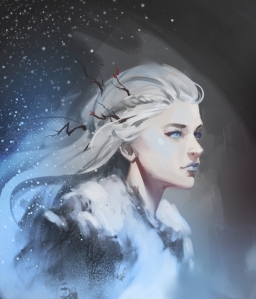 Marzanna (in Polish), Марена (in Russian), Morė (in Lithuanian), Morana (in Czech, Bulgarian, Slovene, Serbian, Bosnian, and Croatian), or Morena (in Slovak and Macedonian), Maslenitsa (in Russia) and also Mara (in Belarusian and Ukrainian), Maržena, Moréna, Mora or Marmora is a Baltic and Slavic goddessassociated with seasonal rites based on the idea of death and rebirth of nature. She is an ancient goddess associated with winter’s death and rebirth and dreams. In Slavic rites the death of the Goddess Marzanna at the end winter, becomes the rebirth of Spring of the Goddess Kostroma (Russian), Lada, Vesna representing the coming of Spring.
Marzanna (in Polish), Марена (in Russian), Morė (in Lithuanian), Morana (in Czech, Bulgarian, Slovene, Serbian, Bosnian, and Croatian), or Morena (in Slovak and Macedonian), Maslenitsa (in Russia) and also Mara (in Belarusian and Ukrainian), Maržena, Moréna, Mora or Marmora is a Baltic and Slavic goddessassociated with seasonal rites based on the idea of death and rebirth of nature. She is an ancient goddess associated with winter’s death and rebirth and dreams. In Slavic rites the death of the Goddess Marzanna at the end winter, becomes the rebirth of Spring of the Goddess Kostroma (Russian), Lada, Vesna representing the coming of Spring.
Dažbog
 Dažbog (Proto-Slavic: *dadjьbogъ,[1] Serbo-Croatian: Dabog, Daždbog, Dajbog; Belarusian, Ukraininan and Bulgarian: Даждбог, Polish: Dadźbóg, Russian: Даж(д)ьбог), alternatively Daždźboh (Belarusian: Даждзьбог), Dazhbog, Dajbog, Dazhdbog, or Dadzbóg, was one of the major gods of Slavic mythology, most likely a solar deity and possibly a cultural hero. He is one of several authentic Slavic gods, mentioned by a number of medieval manuscripts, and one of the few Slavic gods for which evidence of worship can be found in all Slavic nations. Nadaljuj z branjem Dažbog
Dažbog (Proto-Slavic: *dadjьbogъ,[1] Serbo-Croatian: Dabog, Daždbog, Dajbog; Belarusian, Ukraininan and Bulgarian: Даждбог, Polish: Dadźbóg, Russian: Даж(д)ьбог), alternatively Daždźboh (Belarusian: Даждзьбог), Dazhbog, Dajbog, Dazhdbog, or Dadzbóg, was one of the major gods of Slavic mythology, most likely a solar deity and possibly a cultural hero. He is one of several authentic Slavic gods, mentioned by a number of medieval manuscripts, and one of the few Slavic gods for which evidence of worship can be found in all Slavic nations. Nadaljuj z branjem Dažbog
Jarilo
 Jarylo (Cyrillic: Ярило or Ярила; Polish: Jaryło; Croatian: Jura or Juraj; Serbian: Јарило; Slavic: Jarovit), Jaryla(Belarusian: Ярыла), alternatively Yarylo, Iarilo, or Gerovit, is a Slavic god of vegetation, fertility and springtime. The Slavic root jar or yar means spring or summer or strong. Nadaljuj z branjem Jarilo
Jarylo (Cyrillic: Ярило or Ярила; Polish: Jaryło; Croatian: Jura or Juraj; Serbian: Јарило; Slavic: Jarovit), Jaryla(Belarusian: Ярыла), alternatively Yarylo, Iarilo, or Gerovit, is a Slavic god of vegetation, fertility and springtime. The Slavic root jar or yar means spring or summer or strong. Nadaljuj z branjem Jarilo
